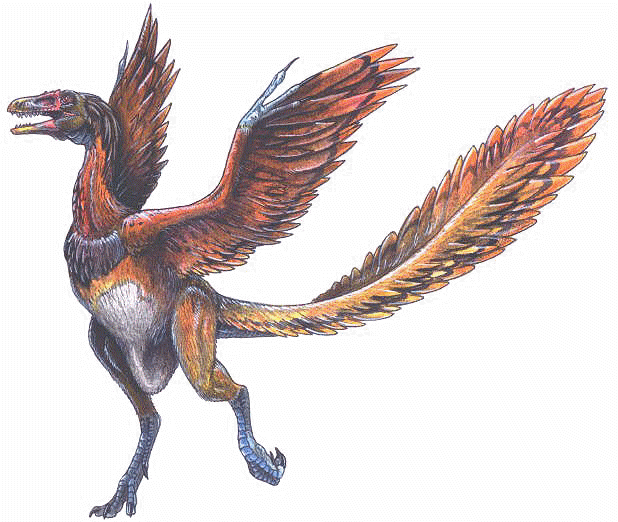|
Archaeopteryx lithographica
(Hermann von Meyer, 1861). |
|
 |
|
Name Means: |
"Ancient Wing" |
Length: |
2 feet (.65 meters) |
|
Pronounced: |
ark-ee-OP-ter-iks |
Weight: |
13 oz. |
|
When it lived: |
Late Jurassic, 150-148 MYA |
|
|
|
Where found: |
Bavaria, Germany |
|
|
|
The Archaeopteryx fossil is considered to be one of the most
important ever discovered. Archaeopteryx is considered by many to be the link between
dinosaurs and birds. It had teeth and claws, but it also had feathers
and wings. There are many questions about this animal that still have
not been answered. Did it fly or could it only glide? Some think it
used its wings to help it jump higher rather than actually fly.
Archaeopteryx
looked very similar to some modern birds, and several of the specimens
clearly show what appear to be true feathers. Upon closer examination, however, scientists have found some
striking differences between Archaeopteryx and modern birds.
Archaeopteryx had a long, stiff, bony tail, unlike modern birds.
Each wing had two separate fingers on the leading wing edges that were
equipped with sharp, curved claws. The biggest differences, however,
are in the skull. It didn't have a beak, but rather a true set of jaws
that were equipped with many small, sharp teeth. Internally, there
were also many differences in the structure of the hipbones, and
Archaeopteryx didn't have a breastbone.
Since the discovery of a single feather in 1860, only seven
additional specimens of Archaeopteryx have been found, all from
the Late Jurassic Solnhofen limestone of southern Germany. The first
skeleton is now housed at the Natural History Museum of London, and
the most spectacular is the famed Berlin Specimen at the Humboldt
Museum of Berlin.
Its name comes from the limestone in which the first
discovered fossil was imprinted. This was a very fine-grained
limestone, which was cut into blocks and highly polished. Pictures
could then be etched into it, making it suitable for lithography, a
type of printing. This fine-grained limestone also retained the
delicate impressions of the fragile feathers.
An Archaeopteryx feather was discovered in 1860, but the
following year, a complete specimen was excavated. Since then, only five other
specimens have been uncovered, with the best specimens being at the
Humboldt Museum in Berlin and the British Museum. The discovery
set off one of the biggest controversies in paleontology history.
Richard Owen was widely regarded as the leading naturalist of the
19th century. Among his many accomplishments, he published the first
important general account of the great group of Mesozoic
land-reptiles, to which he gave the now familiar name of Dinosauria.
In short, he was the first scientist to formally recognize their
existence. Owens wrote one of the main reviews of Charles
Darwin's Origin of Species for the respected Edinburgh Review.
Owen vacillated between accepting or denying evolution but was certain
that Darwin's proposed mechanisms were wrong.
The first Archaeopteryx specimen was discovered only
two years after the publication of Darwin's famous book. In
January 1863, Owen bought the archaeopteryx fossil for the British
Museum. It fulfilled Darwin's prediction that a proto-bird with
unfused wing fingers would be found, but Owen described it
unequivocally as a bird.
In 1868, another renowned British scientist Thomas Henry
Huxley interpreted the Archaeopteryx fossil to be a
transitional bird having many reptilian features. Using the fossils of
Archaeopteryx and Compsognathus, a bird-sized and
bird-like dinosaur, Huxley argued that birds and reptiles were
descended from common ancestors. Decades later, Huxley's ideas fell
out of favor. The recent discovery of many feathered dinosaurs has
proven Huxley to have been right.
In 2004, scientists analyzing a detailed CT scan of
Archaeopteryx's braincase concluded that its brain was
significantly larger than that of most dinosaurs, indicating that it
possessed the brain size necessary for flying. The overall brain
anatomy was reconstructed using the scan. The reconstruction showed
that the regions associated with vision took up nearly one-third of
the brain. Other well developed areas involved hearing and muscle
coordination. (Winter, 2004) The skull scan also revealed the
structure of the inner ear. The structure more closely resembles that
of modern birds than the inner ear of reptiles. These characteristics
taken together suggest that Archaeopteryx had the keen sense of
hearing, balance, spatial perception and coordination needed to fly.
(Alnso, et al., 2004)
There is some controversy about whether Archaeopteryx could
genuinely fly, or only hop around and glide from trees. The lack of a
large breastbone suggests it was not a strong flier, but flight
muscles might have attached to the bird's thick, boomerang-shaped
wishbone. The large wings and long tail, however, suggest that it was
both stable and maneuverable in the air. The shape of the wings is
similar to birds which fly through trees and brush. |
|
|
|
|
|
|
|
|
|
|
Edugraphics.Net | Feenixx Publishing |
|
|
|
|
![]()
